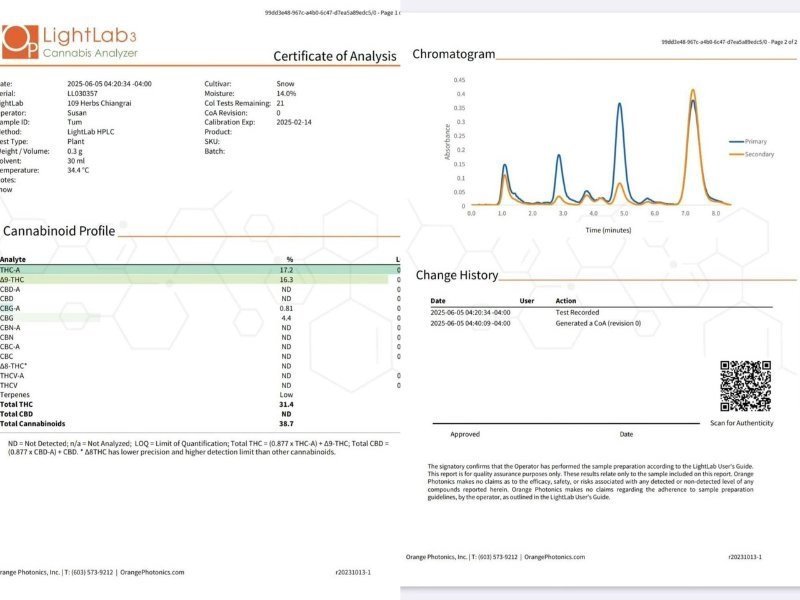
SamuiGrower
Member-
Posts
132 -
Joined
-
Last visited
Recent Profile Visitors
SamuiGrower's Achievements
-
THC Content has Increased 5X in Cannabis Since 2000
SamuiGrower replied to save the frogs's topic in Thailand Cannabis Forum
I would seriously doubt the validity of this test. To have THC and THCa to be nearly equal suggests a spurious result. The majority of THC in flower exists in the acid, non-decarboxylated form. To have THC and THCa almost equal is a red flag. Industry testing averages show a cannabinoid ratio of 80:20 (THCa to THC) so the report is flawed, for certain. Unless 50% of the THCa has miraculously converted to D9-THC through time/temperature decarboxylation, naturally, the test implies a huge error. Also, note CBG is at 4.4% a HUGE number that suggests unconverted THC/THCa has been left “on the table” - harvesting too early. The test, in and of itself, is a red flag. And, yes, as mentioned by a previous poster, you do not add THC+THCa to come up with total THC%. 13% of the total THCa is lost to conversion (decarboxylation) - the weight of the CO2 molecule removed (COO). Tot THC = THC + (THCa * .877). Though LightLab3 uses HPLC protocol, the margin of error is greatly increased by sample preparation and human error. We have seen huge margins of error in the brick and mortar labs we have used in Bangkok as well. Lab shopping in the USA to prop your numbers is a known thing, I can just imagine how the numbers will be “cooked”, here in Thailand. As a closing salvo, current research shows, industry average THC% around 15% in legal rec/med markets. As I like to say, the two biggest lies in the cannabis space are: name of strain and reported THC %. -
As per the latest circulated information…. Thai Cannabis Future Writing Network has proposed some urgent amendments to current ministerial announcement as follows: 1. Protect target groups including children, youth & pregnant women to pave the way for people outside these groups to obtain cannabis without prescription. No smoking in public places. 2. GACP to be required for export products only. All products to be tested prior to distribution. 3. Request to delay enforcement of the Ministry's announcement. ——————————————————————————————————————————- 2. Cancellation of GACP certification for farmers The network proposes to remove the requirement for farmers to have GACP (Good Agricultural and Collection Practices) certification in order to sell cannabis flowers, as it is not directly related to consumer safety. Instead, it proposes an alternative that focuses on testing for contaminants in the end product before it enters the distribution system. If a high standard such as GACP is to be used, it should only be used for production for export. edit: A confusing word salad, as GACP IS directly related to consumer safety. “Testing for contaminants” would be major progress but does not limit a growers practices, pre-harvest, to pesticides or PGR’s. Negating GACP domestically in lieu of testing is a complete contradiction. The statement, GACP is limited to export products, poses the question, where will Thai cannabis flower be exported to? What is the value added benefit to the importer for buying Thai cannabis flower? Does anyone see this happening? All very preliminary and may not be borne out before the ink dries. It sounds dubious at best.
-
THC Content has Increased 5X in Cannabis Since 2000
SamuiGrower replied to save the frogs's topic in Thailand Cannabis Forum
So much misinformation/disinformation….. The correlation is with adolescents NOT adults. It is a contributory factor towards psychosis spectrum disorders, not the only factor. Dr. Fabiano did not do the studies but correlated metadata. The medical science community understands that correlation is NOT causation. There absolutely Is. Do the research without Google, YouTube or social media reposts. ChatGPT is also not accurate unless you tailor your search to peer reviewed science and medical journals. The reported research on this topic however, is not fake. Cannabis in all its forms, recreationally and medically, is NOT genetically engineered. Not even close, though it is coming. It has been heavily hybridized and crossed but it is not GMO. Another widely disproven weed shop myth. The lines between Indica (down) and Sativa (up) have been irreparably blurred through hybridization. For all you disbelievers holding on to this myth, PM me for the Dr. Ethan Russo paper (interview). He is one of the progenitors who settled this. Legalized in 2016. There was a compassionate use act in 1996 that never rolled out (Prop 215) …..A lie travels around the world three times before the truth can put its boots on -
I thought I would help to clarify what GACP (Good Agricultural and Collection Practices) means and what it does not mean, having worked (my company) under its guidance several times. I will address several posters concerns as to PGRs (Plant Growth Regulators) and pesticides. GACP is a set of guidelines and standards for medicinal plants (cannabis) to ensure quality and safety. The guidelines were initially developed in the infancy of medical cannabis legalization by the WHO (World Health Organization) in 2003, although guidelines for botanical derived medicines have been around for quite some time before that. The USA and the EU each have a different set of standards. I suspect Thailand will adopt the EU guidance. The guidelines differ from country to country, state by state (USA). Depending on how products will be used, I.e flower, edible, extract or pharmaceutical. Different production standards can apply and in different jurisdictions. Confusing? Yes. Let me explain. GW Pharmaceuticals produces Epidiolex and Sativex, both cannabis (botanical) derived drugs. Their adherence to GACP and GMP (Good Manufacturing Practices) differs greatly than producing flower in a medical cannabis dispensary. Consistency and repeatability is paramount with pharmaceuticals. Flower, not so much unless a single strain (chemotype) is grown for specific cannabinoids. It is understood that no two cultivators will get the same reported results form multiple strains grown by varying models, conditions and inputs. For the most part, it is self-regulating and self-reporting, as to logs, SOPs and procedural guidelines relating to: cultivation and post-harvest, up to downstream processing (extracts) where GMP guidelines take over. The guidelines were set up for export and sale to pharmaceutical companies. The emphasis is on export, hence the quality control. Inspections and verification of consistency only relate to the downstream products. In the US, there are third party companies authorized to consult and certify GACP (GMP) facilities. Yes, GACP is a certification, but it does NOT assure against the use of pesticides or PGRs. When GACP is applied to medical flower production, there is no stipulation to the cultivation model: indoor (CEA), greenhouse or outdoor. There is no stipulation as to nutrient regiment: organic or non-organic or additional inputs like kelp, humic/fulvic, silicon, etc. The guidance for pesticides is suggestive: “….minimal use”, “…..should be avoided”, with biological pesticides preferred over chemical. PGRs are a contentious subject for sure. We experimented with them many years ago and stopped when they were banned on food crops in the USA. Chitosan and kelp are two PGRs (albeit natural) that are used in cultivation and are not banned. Ethylene, auxins, and cytokinins are also PGR’s that are not banned, as long as they are plant derived. PGRs that are being used in cannabis cultivation by bad actors come from the ornamental horticulture space. Many are known carcinogens. GACP “emphasizes” a strong preference for minimizing chemical interventions to ensure consumer safety and product quality. GACP as it relates to flower, is all about the assurance of contaminant free product. Testing and verification is paramount to GACP, which leads me to Thailand. We have all lived through a grossly unregulated market. A clumsily rolled out legalization, no tax structure/remittance to municipality or state, no microbial or heavy metal testing, no THC % testing and blatant lies as to the term, ‘organically grown’. GACP is ALL about the consumer. I have “harped” about the lack of testing on this forum for quite some time. As “concerned” as some of you might be, the overwhelming topics are about THC%, names of strains (another HUGE lie) and where to buy the perceived best at the lowest price. Some of you are human THC% meters, able to look at a photo on this forum, and tell what the THC amount is. Quite the skill! You should all be concerned about contamination, pre and post-harvest. The most obvious problem I see throughout Thailand is post-harvest handling and degradation of quality in the shops. So, I ask you, how well will a ‘certified’ GACP medical cannabis program fare, here in Thailand? Will there be inspections? Audits? Testing? Stringent record keeping? Training? Will growers make workers wear hair nets? LOL. How will present growers come up to speed? The process is NOT self directed. It requires external evaluation and, from what I have experienced, infrastructure purchases, as well as a top down commitment to training and onerous record keeping. I foresee one hairy, hot mess replaced with another, and as well executed and deficient as the present status quo. It would make for good conversation to hear what smokers and growers (so few on this forum, if any?) feel about GACP and testing. In fact, in well developed legal markets, like the USA and Canada, it is the consumer that dictates quality standards as to what excellence is. THAT drives the market! A bunch of whining expats will never move the needle. GACP is not the needed criteria for assuring safety and purity to the consumer, mandatory batch testing for contaminants (pesticides, microbial and heavy metals) and seed-to-sale compliance is. Please chime in.
-
NO, not BS. Cannabis does indeed affect sleep architecture: namely REM sleep (Rapid Eye Movement). In fact, all the cannabinoids do, in one way or another with the exception of CBD. The problem with cannabis (namely THC, and all the forms in which we consume it) is the difference between short and long term use (for sleep). Tolerance (as in every day chronic use) shifts the effectiveness of the “pros” and it’s therapeutic affects to the “cons” of REM suppression, sleep fragmentation (multiple awakenings) and prolonged sleep onset. There are short and long term effects. THC is quite effective in inducing faster sleep onset, and because of this, is used in PTSD and insomnia treatment. THC reduces nightmares by reducing REM sleep. Initially, THC increases slow wave, deep sleep cycles. However, chronic everyday use shifts the balance away from REM sleep and does the opposite. THC, for short term use is quite effective in managing fast onset sleep, PTSD, nightmares and anxiety, but chronic use defined by developing a tolerance, and most smokers on this forum understand this, does the opposite. In fact, cold turkey cessation can result in vivid dreams, nightmares and insomnia. This is not speculative. THC binds to CB1 receptors and alters neurotransmitters that regulate sleep rhythm and directly affects REM sleep. There are multiple research papers written on the subject you can research. Google and YouTube are NOT the recommended path for research though. lol.
-
A poster in this forum once wrote, “…..the difference between getting high on 15% THC flower and 30% THC flower is one hit! “ I found this so humorous AND so true. Lol. I have smoked “vintage” hash that was several years old and yes, it still got the job done. The takeaway catchphrase for those that enjoy flower: “Fresh is BEST”
-
Cannabis begins to degrade immediately from post harvest. You can slow it down by controlling the environment in which it is dried, cured and stored, but can not keep it at bay for an extended time. Degradation of flower directly affects quality and value. Cannabinoids (THC, CBD, etc al.), terpenes and flavonoids degrade by light (photo-oxidation - primarily UV light), enzymes, and oxygen/air. Monoterpenes are the most volatile and begin to evaporate (volatilize) almost immediately. Chlorophyll degrades through enzymatic and microbial degradation. This is a good thing, reducing harshness and affecting the flavor in a positive way. Decarboxylation, the conversion of THCa to THC (also a good thing) occurs slowly. The conversion of THC to CBN also occurs and is an indication of “old” flower - not a good thing! A research paper I saw a couple of years back showed a linear decrease of THC and other cannabinoids over time, regardless of storage techniques used. Temperature, humidity and light are the major factors attributing to quality and purity loss. On a commercial level, cannabis is viewed as a perishable crop and should be sold and consumed before any quality characteristics are compromised. For personal/hobby grows and consumption, cool, dry environments will slow down the process. Vacuum sealing and refrigeration will slow terpene loss but will not abate CBN conversion. Freezing will do the same but if the flower has more than 5-10% moisture it will not ‘look’ very good, but if it is for personal consumption, no big deal, right? A humidity pack (63%) with your flower in a sealed mason jar, kept out of direct light, in a cool place is the correct handling for those of you who enjoy connoisseurship. One of my pet peeves, here in Thailand, is the handling and display of flower in dispensaries/weed shops. That pale, bleached look, that makes all flower look the same is a result of photo UV oxidation. High temperatures and humidity fluctuation certainly doesn’t help. Does your local weed shop turn off the air cons at the end of the day? Where do they store their flower when they are not open? Oversupply and poor merchandising of perishable flower is the issue. It always reminds me of an overcooked green vegetable - pale and drab. i hope this was helpful.
-
Photos of your Grow in Thailand
SamuiGrower replied to Mr Meeseeks's topic in Thailand Cannabis Forum
Male -
Re: What can be done with cannabis trim?
SamuiGrower replied to Marcus Martin's topic in Thailand Cannabis Forum
Rest assured there is an outlet/market for cannabis trim in the grossly unregulated Thai cannabis industry. Stating illegalities to processing, edibles, oils, tinctures and topicals, is to ignore the fact that anything but flower exists in the marketplace. The first, and obvious, downstream use is in “washing”, to produce water hash: a relatively low tech, low labor, mechanical process. This can be done with fresh or dried trim. I see it marketed throughout Thailand as hash, bubble hash or as unpressed kief. If a commercial grower is not utilizing or selling off their trim, they may just be in the ‘flower’ market or not vertically integrated to make/sell other products or interested in selling their trim to processors. The ‘other’ use of trim would be for extraction, to produce: M.I.E’s/C.I.E’s (marijuana/cannabis infused edibles), oils, tinctures and topicals. Because cannabinoids are oil soluble, a solvent (alcohol, hydrocarbon) is typically used for extraction. The solvent is then evaporated to create a concentrate that is then incorporated into the final above mentioned product. This is an over simplification as other refinement steps may be incorporated. Lastly, yes, the trim could be sold off as trim, much like popcorn buds are sold. This represents a lower tier of buyer. -
Cuttings from Auto flowering plants, is it possible?
SamuiGrower replied to Bday Prang's topic in Thailand Cannabis Forum
And, when crossing/hybridizing C. Ruderalis (autoflowers), the dominant autoflower trait (day neutral flowering) becomes recessive, appearing in only 25% of the crosses (autoflower x autoflower). If crossing with a photoperiod plant, the autoflower trait (day neutral) is lost. It essentially takes 5-6 crosses to stabilize the autoflowering trait. Autoflower strains are extremely fickle and unpredictable in the best of environments. The slightest bit of stress and they will flower unpredictably with minimal yields. -
Any type of leafhopper is not welcome around cannabis (especially in a tent) and is NOT harmless, katydids included. They are herbivores and eat leaves, not other predatory insects, and should not be there. Cannabis thrips do NOT eat fungus. They are not beneficial and are the bane of any cannabis grower. A thrip infestation can be above and below the substrate and can devastate a crop - especially in flower. “Lost Coast” is predominantly soybean oil, peppermint oil, a little citric acid and isopropyl. It acts the same way as neem oil by smothering soft body insects. The best way to use Lost Coast, neem oil and potassium salts of fatty acids (Insecticidal soap) is as a preventative IPM during vegetative growth. Once cannabis is in flower (post week F3) there is very little you can do. Use of Lost Coast, Neem oil and insecticidal soap will show little results after you have a problem. i agree with the post that it is unlikely you had septoria. Likely powdery mildew, grey mold, fusarium, pythium etc. The bad news: you are responsible for your thrip and fungus situation (as well as visiting leafhoppers) through poor management. The entire idea of tent growing is the same as CEA (controlled environment agriculture) - a relative sealed environment where YOU control the heat, humidity, air movement, light cycles, IPM and general plant husbandry. Leaving doors open, screens, and your tent(s) open to the environment obviously invites the results you are experiencing. My advice: Seal your tents from the outdoor environment. Use Lost Coast, Neem, Insecticidal Soap as a preventative spray (IPM) once a week during vegetative growth and the first week of flipping to flower. Place a small space heater on a thermostat during cool nights, warm days. It also knocks down humidity at night. More air movement keeps sporulation of PM, septoria, fusarium and pythium from setting in. Incorporate a silica product, increase calcium and increase air movement in a clean growing environment and your plants will naturally ward off predatory (soft body) insects and molds.
-
Question about drying before decarboxylation
SamuiGrower replied to JackGats's topic in Thailand Cannabis Forum
Decarboxylation, conversion from THCa to THC, the psychoactive form, begins after harvest, from drying onwards. Drying and curing (without heat) is a slow, natural, linear process of decrboxylation. It is not necessary to cure your flower for extraction. Curing, furthers decarboxylation but should be considered more for flavor development by degradation/conversion of chlorophyll, sugars and starches. What is critical though, is thorough drying of your flower before decarboxylation for efficient conversion. A good friable, milled flower should be your starting point. -
Gummies don’t work – so what can I try next .
SamuiGrower replied to Custard boy's topic in Thailand Cannabis Forum
If you have pre-existing medical conditions, especially heart related, the best advice you can get would come from a medical doctor. Your arrhythmia should be of great concern. The medication you are taking, Flecanide (Tambocor) regulates your heart rhythm. Cannabis directly effects: heart rhythm (cardiovascular effects), increasing heart rate (tachycardia) and blood pressure (increasing and decreasing). Combining cannabis and your heart meds can increase your risk of adverse events. Both Flecanide (Tambocor) and cannabis are processed through the liver enzyme system (P450). Cannabis can influence the metabolism of that drug that can alter enzyme absorption leading to either toxicity or sub-therapeutic effects of your heart meds. The Imatnib you are taking works directly with enzyme P450 functions and can have some nasty side effects (the least of your worries) in conjunction with cannabis and Flecanide. My PSA to you (and others), if you have medical issues, is seek qualified medical advice when considering cannabis use for any consideration. -
Gummies don’t work – so what can I try next .
SamuiGrower replied to Custard boy's topic in Thailand Cannabis Forum
Thanks @stoner. I’ve said a few words on the subject as an anti-hero, in an industry that I am a staunch advocate of in all ways except for lies. We are at an ‘event horizon’ with cannabis; research dollars are pouring in everyday, in both public and private partnerships. Soon enough we will understand all the pharmacokinetics of all the cannabinoids and secondary metabolites of cannabis. BUT until then… …The science does not support the internet/social media claims at present. The claims range from the sublime to the ridiculous, and I explain all the whys. I have written a few things on this forum, and have included a few links. If you want to go in further depth, look at my posts……or not. To address the post about CBD and Sleep, here is an extract from a similar post: ”Using CBD as a sleep aid is a “movement” magnified on social media. Because it has anti-anxiety effects it has been co-opted as a sleep aid and this is the furthest thing from the truth. It has more placebo inducing sleep effect than the CBD itself. It is NOT a sleep aid. The anti-anxiety effect only works in the presence of THC. CBD modulates all the effects of THC, not being able to bind to Endocannabinoid receptors on its own. ” Required strength CBD oil for a good night sleep CBD products don't ease pain and are potentially harmful, study finds Required strength CBD oil for a good night sleep cont. -
Cannabis Can Help Prevent Seizures
SamuiGrower replied to 123Stodg's topic in Thailand Cannabis Forum
Epidiolex https://www.epidiolex.com/epidiolex-results












